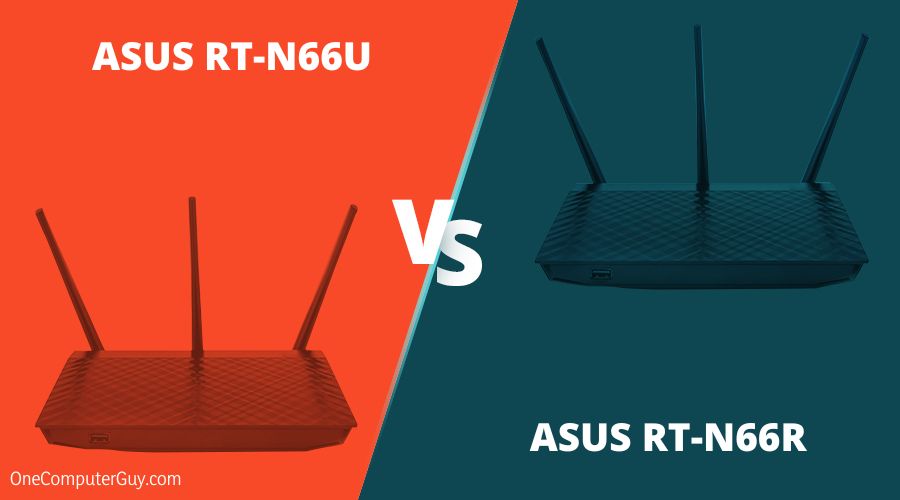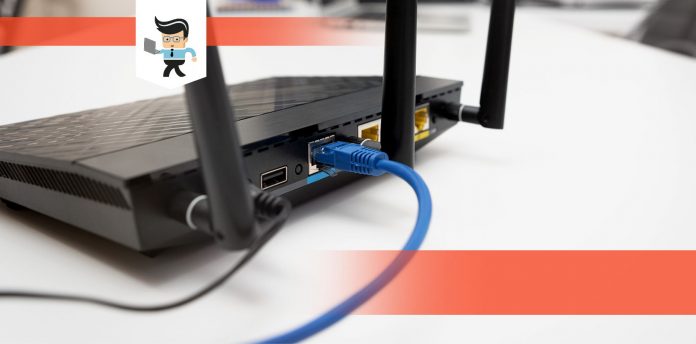The RT-N66R vs. RT-N66U head-to-head comparison article features two routers that have been going strong and getting better for many years. While many devices have popped up since their introduction, these two models continue to uphold the class and quality features needed to enjoy reliable internet connections.
 They may be from the same brand with a similar outlook and internal components, but they have some subtle differences that translate into unique experiences for different users.
They may be from the same brand with a similar outlook and internal components, but they have some subtle differences that translate into unique experiences for different users.
In this review, you get to see what makes them tick, their drawbacks, and the edge they hold over each other. Read on.
Contents
A Look at the Key Specifications
| Product | Key Specifications |
| RT-N66R |
|
| RT-N66U |
|
RT-N66U and RT-N66R: How Do These Routers Measure Up?
Asus is responsible for creating some of the best quality routers on the market, and these two models aren’t any different thanks to features and capabilities users will enjoy. They both have a dual-band network, USB ports, the latest security types, and the speeds to perform various tasks.
With a closer look at both, you’ll have a clear understanding of which one works best for you.
1. ASUS RT-N66U Dual-Band Wireless-N900 Gigabit Router
Pros
- It provides stable wireless signals
- It can work as a stand-alone VPN server
- Supports file, printer, and 3G sharing
- Sleek design with an outstanding performance
Cons
- The slow data rate on the 2.4 GHz band
The Asus RT-N66U specs are some of the best and were once described as the latest flagship in the Asus lineup featuring the 2.4 GHz and 5 GHz Concurrent Dual-Band Transmissions.
It remains an excellent choice for many uses and sports four Gigabyte LAN ports and one Gigabyte WAN port. There are USB ports and adjustable antennas as well. Besides that, you also get the ASUSWRT Dashboard UI for Easy Setup, Signal Monitoring, and Network Application Control.
– Dual-Band Frequency: Allocate Bandwidth
The Asus RT N66U firmware does a lot to give you a faster connection even when multiple devices are connected, but the dual-band frequency also helps. Its concurrent transmissions give off a strong signal strength, and ultra-fast connection rates reach about 900 Mbps.
Also, you can allocate bandwidth with more simple tasks like emailing and surfing the net going through the 2.4 GHz band. You can use the 5 GHz band for more Internet-intensive tasks like downloads and playing online games.
– Ports: Works Fine With Wired Options
You can connect wires to the router via the Gigabit Ethernet ports for fast and reliable Internet performance. Also, there’s a download master for wireless data storage and access to the router-connected USB storage devices.
File Sharing, printer sharing, and 3G sharing through the two USB ports add more options to the device.
On the whole, you have four LAN Ports – 4 x 10/100/1000M and one WAN Ports – 1 x 10/100/1000M.
– Antennas: For Wider Coverage
You can get extended wireless coverage thanks to the three detachable and high-powered antennas. With them, more devices can connect to the broader range.
– Setup: Smooth as Ice
Get going on your router, thanks to the smooth Asus RT N66U setup. The ASUSWRT Dashboard UI also contributed to an easy setup and network application control.
– Overview
As far as capable and reliable routers go, this one will suit users who operate in a vast space. The antennas boost range and coverage while you get fast speeds on both bands.
2. ASUS RT-N66R Dual-Band Wireless-N900 Gigabit Router
Pros
- Both wired and wireless capabilities
- Fast 900 Mbps wireless data rates
- It comes with USB and Ethernet ports
- It’s simple to setup
Cons
- It costs more for some users
The RT-N66R boasts a strong connection over connections to multiple devices. That’s one of its strongest suits coupled with a wireless and wired feature you’d appreciate. Moreover, it’s a dual-band router sporting speeds up a combined 900 Mbps.
With that, you can get a lot done, including streaming videos online and downloading your favorite content.
– Design: Cool Textured Finish
The exterior of this router is great looking with a textured finish and the blue LED lights that indicate what you’re up to.
There’s a detachable stand and three removable antennas. The router can assume a vertical position using the stand provided.
– Ports: Take Advantage of More Connectivity Options
The Asus RT-N66R has four Gigabit LAN ports round the back, a single gigabit WAN port, and two USB inputs for printers or external hard disks.
The USB ports are of particular importance since you can use them with five different onboard applications. That includes AIDisk, which allows a USB drive to be shared over the internet and used as a network printer.
– Setup: Smooth and to the Point
Setup is easy. When you connect the WAN Ethernet cable, LAN Ethernet cables, and power cord, open a browser, and immediately, you’d be redirected to the RT-N66R’s configuration page.
On the page, you’ll be able to set up your router to detect the internet connection before you proceed to secure your dual-band networks.
– Dual-Band: Expand Your Wireless Internet
Just like we pointed out in the Asus RT-N66U review, this RT-N66R comes with the usual LAN, WAN, and wireless configuration options. You can use them on either of the dual-band 2.4GHz or 5GHz bands.
You can also set up a VPN server, which allows connection straight to your home network when away from home.
In addition, this router is compatible with DD-WRT should you want more control over your router. However, the standard Asus firmware is up to the job unless you are the ultimate power user.
– Overview
Overall, this router is a good recommendation for heavy Internet users thanks to a decent range, speeds of 900 Mbps, and standard wireless hardware.
RT-N66U vs. RT-N66R: Head to Head Comparison
The main difference between RT-N66U and RT-N66R is, RT-N66U is more consistent compared to RT-N66R.
Frequency
-
Winner: Both
With the two routers sporting the dual-band frequency, there isn’t a winner here. We know both bands are helpful for various reasons depending on the functions you do per time. We’ll advise you to use the 2.4GHz band for less intensive tasks, while the 5GHz band can take care of heavier functions like online gaming.
Security Protocol
-
Winner: Both
Coming from the same brand, both routers incorporate the WEP, WPA-PSK, and WPA2-PSK protocols to keep users safe while surfing the internet. What’s more, you have a say in what your kids decide to do online, thanks to the parental control features both encourage.
Speed, Range, and Connectivity
-
Winner: Both
The RT-N66R specs, much like that on the RT-N66U, feature components covering many areas, with the speed level improved across different functions. They also come equipped with Gigabit Ethernet ports that bring forth fast and reliable Internet performances.
The data transfer rate of the two routers is 900 Mbps. That’s fast enough for any function and many devices connected to your home network.
What’s more, they each come with three detachable antennas that help keep the coverage stable. That’s why these two routers are billed to cover up to 2,000 square feet without hassle.
Setup
-
Winner: Both
The Asus brand already has a reputation for its simple setup and easy-to-use interface. The RT-N66U and RT-N66R follow through on that because you set them up without issues. The prompts are easy to follow, and everything is well organized to get you using the Internet connection within a few minutes.
Frequently Asked Questions
1. Which should I choose between the RT-N66U and RT-N66R?
While the choice of router is up to the user, we can state that these two devices are reliable and will offer a solid and impressive performance in most cases.
You’re always going to choose either depending on the kind of task you need it for, and both models offer 900 Mbps over a good range and strong signals that should be good enough for less demanding internet activities.
In addition to that, the RT-N66U has a slightly higher cost and we lean towards it if we have to make a decision. The extra ports on the two indicate their support for wired connections, including a USB port for file sharing and data transmission.
The Gigabit ports will let you connect to a wired network, while the three antennas on either router will increase signal and coverage.
Conclusion
These two routers mean business with identical features and excellent specifications. You can enjoy a host of features to keep you busy online. That’s because they both have the range, speed, and coverage to help you play games, surf the net, and do much more.
The fact is that the RT-N66U is Asus’ first N900 router and is the feature-rich follow-up to the highly popular RT-N56U. It also has a cloud-enabled system.
However, it’s our opinion that there’s very little to tell them apart. Down from the frequency band, data rate, and ports, they sport the same features and offer similar performance. But we find ourselves liking the consistency of the RT-N66U model, and we think this makes for a slight advantage over its counterpart.








